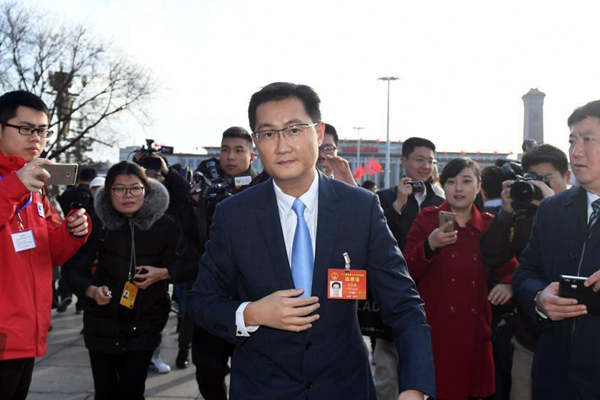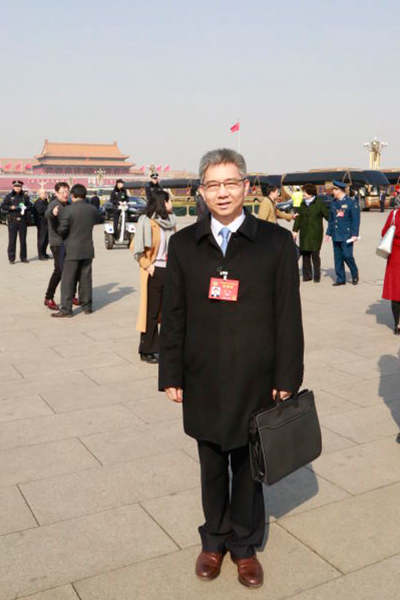Robin Li, chairman and CEO of Baidu
Key words: Artificial intelligence (AI)
There was a time when the use of AI technology in applications was considered impossible, but it is now a reality. The government departments should announce preferential policies to encourage the use of AI in other industries. The technology should be enhanced and used to address issues such as finding missing children and easing traffic flow.

Tencent’s CEO Pony Ma, a member of the CPPCC National Committee, attends the fifth session of the 12th National Committee of the Chinese People’s Political Consultative Conference in Beijing, on Mar 5, 2017. [Photo/chinanews.com]
Pony Ma, founder and CEO of Tencent
Key words: Digital economy; Guangdong-Hong Kong-Macao Bay Area; safety of minors online; protection of personal information; digital culture industry; big data, cloud computing; and urban environmental protection.
The Guangdong-Hong Kong-Macao Bay Area is home to China’s leading tech industries and financial services, as well as a manufacturing hub. Favorable policies should be introduced. The adoption of preferential tax rebate policies in the area should be encouraged to promote growth, and entry threshold between the mainland and Hong Kong should be loosened to retain talent.
Dong Mingzhu, chairwoman of Gree Electric Appliances Inc
Keywords: Creativity and innovation; real economy
Simply imitating or using the technologies of others will no longer work well. While many companies are relying on buying technologies, it is only through innovation that the Chinese-made products can be upgraded. Acquiring technologies can never make a company grow.
The benefit of supply-side structural reform is that Chinese companies can use their talents to create more top products. The government will take steps to better upgrade the real economy through innovation and help accelerate the development of emerging industries.
Lei Jun, founder and CEO of Xiaomi
Keywords: Internet of Things (IoT); national standard for smart home; entrepreneurial environment; new retail
The Internet of Things (IoT) will become the next industry worth more than 1 trillion yuan, far beyond mobile internet. The launch of a national standard for smart home will put China at the global forefront.
The government should put more emphasis on reforms of commodity circulation while continuing the supply-side structural reform. New retail sector wants a combination of both online and offline. The sector uses internet to help brick-and-mortar retailers achieve transformation and upgrading, and to improve user experience and efficiency.
Yang Yuanqing, president and CEO of Lenovo
Keywords: Real economy; educational resources; schoolchildren’s meals
The shift from real economy to virtual economy is happening because the former has much lower returns than the latter. And also because the real economy faces overcapacity, difficult financing, and heavy costs. China’s manufacturing sector is experiencing the growing pains of structural transformation, as low-cost competitiveness is losing its advantages and new competitiveness has not yet developed.
To solve the problem, we need to reduce cost, deflate asset bubble and cool the overheating virtual economy, as well as carrying out the supply-side reform, developing new technologies, new products and new markets and strengthening real economy’s competitiveness.
Zong Qinghou, chairman and general manager of China’s largest beverage company Hangzhou Wahaha Group
Keywords: Real economy; globalization
The internet is a double-edged sword that can boost real economy’s development and cause damage. While the internet can be used to improve work efficiency and productivity, many e-commerce companies have disrupted the pricing system in the real economy through promotions and buying web traffic.
To improve livelihoods, build a moderately prosperous society and provide everyone prosperity, the real economy should be developed first.
Xu Jiayin, chairman of China’s real estate company Evergrande Group
Keywords: Real estate regulatory mechanism; property tax
The long-term real estate price control mechanism should take into account regional differences, construction standards and building conditions. The qualification certification of real estate developers should be further perfected.
Li Shufu, chairman of automobile company Zhejiang Geely Holding Group
Keywords: Methanol-fueled vehicle, autonomous vehicle
To deal with the problem of environmental protection and the shortage of oil resources, the methanol-fueled vehicle should be promoted. The road of energy diversification based on China’s energy structure and market should be taken to mitigate the challenge of energy safety and improve air quality.
Restrictions on accurate mapping should be prudently loosened to reduce barriers to developing autonomous vehicle technology.
Zhang Jindong, chairman of Suning
Keywords: E-government; youth entrepreneurship
While the development of China’s e-government has achieved remarkable progress, the electronic tax management has advanced slowly and has not significantly reduced the tax payment costs yet. An entire electronic process of tax collection should be promoted to reduce companies’ costs.

He Yu, a member of the CPPCC National Committee and chairman of China General Nuclear Power Corp, attends the opening ceremony of CPPCC National Committee on Mar 3, 2017.[Photo provided to chinadaily.com.cn]
He Yu, chairman of China General Nuclear Power Corp
Keywords: Nuclear power technology
The development of Hualong One reactor, one of China’s third-generation domestic nuclear power projects, should be promoted, because it has advantages of high safety, reliable technology, strong industrial support capacity and economic competitiveness. Getting the nuclear power sector back on a healthy sustainable track will help China achieve its emissions reduction target.
Guo Guangchang, chairman of Fosun Group
Keywords: Smart economy, supply-side reform, elderly care service, medical AI, liability insurance
The “customer-to-manufactory” (C2M) model, based on the internet’s permeation of other industries, is a crucial path to push forward the supply-side reforms. It can better understand customers’ needs, and guides the design and manufacturing at the very beginning, to construct a new supply-demand relationship. The model can improve efficiency and lead to more low-cost, personalized and valuable products.
